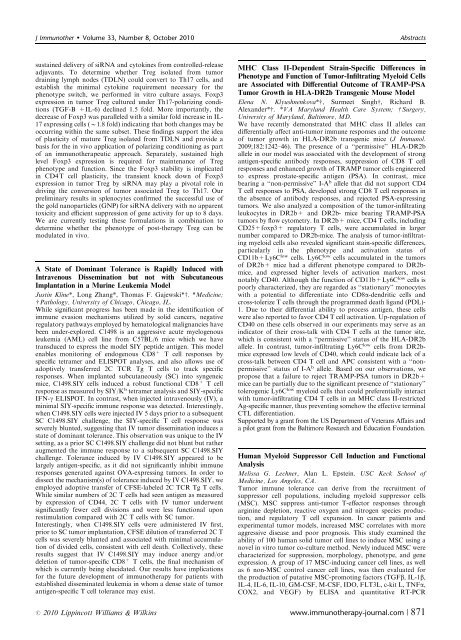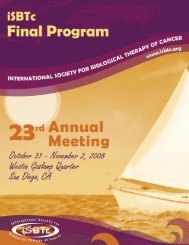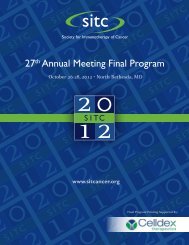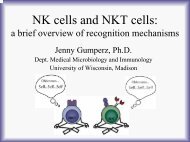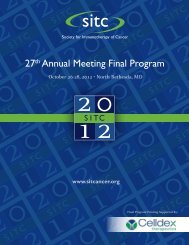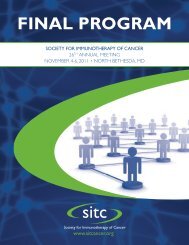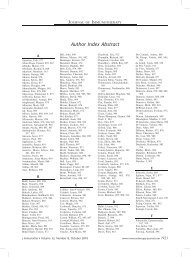Abstracts for the 25th Annual Scientific Meeting of the International ...
Abstracts for the 25th Annual Scientific Meeting of the International ...
Abstracts for the 25th Annual Scientific Meeting of the International ...
Create successful ePaper yourself
Turn your PDF publications into a flip-book with our unique Google optimized e-Paper software.
J Immuno<strong>the</strong>r Volume 33, Number 8, October 2010<br />
<strong>Abstracts</strong><br />
sustained delivery <strong>of</strong> siRNA and cytokines from controlled-release<br />
adjuvants. To determine whe<strong>the</strong>r Treg isolated from tumor<br />
draining lymph nodes (TDLN) could convert to Th17 cells, and<br />
establish <strong>the</strong> minimal cytokine requirement necessary <strong>for</strong> <strong>the</strong><br />
phenotype switch, we per<strong>for</strong>med in vitro culture assays. Foxp3<br />
expression in tumor Treg cultured under Th17-polarizing conditions<br />
(TGF-B +IL-6) declined 1.5 fold. More importantly, <strong>the</strong><br />
decrease <strong>of</strong> Foxp3 was paralleled with a similar fold increase in IL-<br />
17 expressing cells (B1.8 fold) indicating that both changes may be<br />
occurring within <strong>the</strong> same subset. These findings support <strong>the</strong> idea<br />
<strong>of</strong> plasticity <strong>of</strong> mature Treg isolated from TDLN and provide a<br />
basis <strong>for</strong> <strong>the</strong> in vivo application <strong>of</strong> polarizing conditioning as part<br />
<strong>of</strong> an immuno<strong>the</strong>rapeutic approach. Separately, sustained high<br />
level Foxp3 expression is required <strong>for</strong> maintenance <strong>of</strong> Treg<br />
phenotype and function. Since <strong>the</strong> Foxp3 stability is implicated<br />
in CD4 T cell plasticity, <strong>the</strong> transient knock down <strong>of</strong> Foxp3<br />
expression in tumor Treg by siRNA may play a pivotal role in<br />
driving <strong>the</strong> conversion <strong>of</strong> tumor associated Treg to Th17. Our<br />
preliminary results in splenocytes confirmed <strong>the</strong> successful use <strong>of</strong><br />
<strong>the</strong> gold nanoparticles (GNP) <strong>for</strong> siRNA delivery with no apparent<br />
toxicity and efficient suppression <strong>of</strong> gene activity <strong>for</strong> up to 8 days.<br />
We are currently testing <strong>the</strong>se <strong>for</strong>mulations in combination to<br />
determine whe<strong>the</strong>r <strong>the</strong> phenotype <strong>of</strong> post-<strong>the</strong>rapy Treg can be<br />
modulated in vivo.<br />
A State <strong>of</strong> Dominant Tolerance is Rapidly Induced with<br />
Intravenous Dissemination but not with Subcutaneous<br />
Implantation in a Murine Leukemia Model<br />
Justin Kline*, Long Zhang*, Thomas F. Gajewski*w. *Medicine;<br />
w Pathology, University <strong>of</strong> Chicago, Chicago, IL.<br />
While significant progress has been made in <strong>the</strong> identification <strong>of</strong><br />
immune evasion mechanisms utilized by solid cancers, negative<br />
regulatory pathways employed by hematological malignancies have<br />
been under-explored. C1498 is an aggressive acute myelogenous<br />
leukemia (AML) cell line from C57BL/6 mice which we have<br />
transduced to express <strong>the</strong> model SIY peptide antigen. This model<br />
enables monitoring <strong>of</strong> endogenous CD8 + T cell responses by<br />
specific tetramer and ELISPOT analyses, and also allows use <strong>of</strong><br />
adoptively transferred 2C TCR Tg T cells to track specific<br />
responses. When implanted subcutaneously (SC) into syngeneic<br />
mice, C1498.SIY cells induced a robust functional CD8 + T cell<br />
response as measured by SIY/K b tetramer analysis and SIY-specific<br />
IFN-g ELISPOT. In contrast, when injected intravenously (IV), a<br />
minimal SIY-specific immune response was detected. Interestingly,<br />
when C1498.SIY cells were injected IV 5 days prior to a subsequent<br />
SC C1498.SIY challenge, <strong>the</strong> SIY-specific T cell response was<br />
severely blunted, suggesting that IV tumor dissemination induces a<br />
state <strong>of</strong> dominant tolerance. This observation was unique to <strong>the</strong> IV<br />
setting, as a prior SC C1498.SIY challenge did not blunt but ra<strong>the</strong>r<br />
augmented <strong>the</strong> immune response to a subsequent SC C1498.SIY<br />
challenge. Tolerance induced by IV C1498.SIY appeared to be<br />
largely antigen-specific, as it did not significantly inhibit immune<br />
responses generated against OVA-expressing tumors. In order to<br />
dissect <strong>the</strong> mechanism(s) <strong>of</strong> tolerance induced by IV C1498.SIY, we<br />
employed adoptive transfer <strong>of</strong> CFSE-labeled 2C TCR Tg T cells.<br />
While similar numbers <strong>of</strong> 2C T cells had seen antigen as measured<br />
by expression <strong>of</strong> CD44, 2C T cells with IV tumor underwent<br />
significantly fewer cell divisions and were less functional upon<br />
restimulation compared with 2C T cells with SC tumor.<br />
Interestingly, when C1498.SIY cells were administered IV first,<br />
prior to SC tumor implantation, CFSE dilution <strong>of</strong> transferred 2C T<br />
cells was severely blunted and associated with minimal accumulation<br />
<strong>of</strong> divided cells, consistent with cell death. Collectively, <strong>the</strong>se<br />
results suggest that IV C1498.SIY may induce anergy and/or<br />
deletion <strong>of</strong> tumor-specific CD8 + T cells, <strong>the</strong> final mechanism <strong>of</strong><br />
which is currently being elucidated. Our results have implications<br />
<strong>for</strong> <strong>the</strong> future development <strong>of</strong> immuno<strong>the</strong>rapy <strong>for</strong> patients with<br />
established disseminated leukemia in whom a dense state <strong>of</strong> tumor<br />
antigen-specific T cell tolerance may exist.<br />
MHC Class II-Dependent Strain-Specific Differences in<br />
Phenotype and Function <strong>of</strong> Tumor-Infiltrating Myeloid Cells<br />
are Associated with Differential Outcome <strong>of</strong> TRAMP-PSA<br />
Tumor Growth in HLA-DR2b Transgenic Mouse Model<br />
Elena N. Klyushnenkova*w, Surmeet Singhw, Richard B.<br />
Alexander*w. *VA Maryland Health Care System; w Surgery,<br />
University <strong>of</strong> Maryland, Baltimore, MD.<br />
We have recently demonstrated that MHC class II alleles can<br />
differentially affect anti-tumor immune responses and <strong>the</strong> outcome<br />
<strong>of</strong> tumor growth in HLA-DR2b transgenic mice (J Immunol.<br />
2009;182:1242–46). The presence <strong>of</strong> a ‘‘permissive’’ HLA-DR2b<br />
allele in our model was associated with <strong>the</strong> development <strong>of</strong> strong<br />
antigen-specific antibody responses, suppression <strong>of</strong> CD8 T cell<br />
responses and enhanced growth <strong>of</strong> TRAMP tumor cells engineered<br />
to express prostate-specific antigen (PSA). In contrast, mice<br />
bearing a ‘‘non-permissive’’ I-A b allele that did not support CD4<br />
T cell responses to PSA, developed strong CD8 T cell responses in<br />
<strong>the</strong> absence <strong>of</strong> antibody responses, and rejected PSA-expressing<br />
tumors. We also analyzed a composition <strong>of</strong> <strong>the</strong> tumor-infiltrating<br />
leukocytes in DR2b+ and DR2b- mice bearing TRAMP-PSA<br />
tumors by flow cytometry. In DR2b+ mice, CD4 T cells, including<br />
CD25+foxp3+ regulatory T cells, were accumulated in larger<br />
number compared to DR2b-mice. The analysis <strong>of</strong> tumor-infiltrating<br />
myeloid cells also revealed significant stain-specific differences,<br />
particularly in <strong>the</strong> phenotype and activation status <strong>of</strong><br />
CD11b+Ly6C low cells. Ly6C low cells accumulated in <strong>the</strong> tumors<br />
<strong>of</strong> DR2b+ mice had a different phenotype compared to DR2bmice,<br />
and expressed higher levels <strong>of</strong> activation markers, most<br />
notably CD40. Although <strong>the</strong> function <strong>of</strong> CD11b+Ly6C low cells is<br />
poorly characterized, <strong>the</strong>y are regarded as ‘‘stationary’’ monocytes<br />
with a potential to differentiate into CD8a-dendritic cells and<br />
cross-tolerize T cells through <strong>the</strong> programmed death ligand (PDL)-<br />
1. Due to <strong>the</strong>ir differential ability to process antigen, <strong>the</strong>se cells<br />
were also reported to favor CD4 T cell activation. Up-regulation <strong>of</strong><br />
CD40 on <strong>the</strong>se cells observed in our experiments may serve as an<br />
indicator <strong>of</strong> <strong>the</strong>ir cross-talk with CD4 T cells at <strong>the</strong> tumor site,<br />
which is consistent with a ‘‘permissive’’ status <strong>of</strong> <strong>the</strong> HLA-DR2b<br />
allele. In contrast, tumor-infiltrating Ly6C low cells from DR2bmice<br />
expressed low levels <strong>of</strong> CD40, which could indicate lack <strong>of</strong> a<br />
cross-talk between CD4 T cell and APC consistent with a ‘‘nonpermissive’’<br />
status <strong>of</strong> I-A b allele. Based on our observations, we<br />
propose that a failure to reject TRAMP-PSA tumors in DR2b+<br />
mice can be partially due to <strong>the</strong> significant presence <strong>of</strong> ‘‘stationary’’<br />
tolerogenic Ly6C low myeloid cells that could preferentially interact<br />
with tumor-infiltrating CD4 T cells in an MHC class II-restricted<br />
Ag-specific manner, thus preventing somehow <strong>the</strong> effective terminal<br />
CTL differentiation.<br />
Supported by a grant from <strong>the</strong> US Department <strong>of</strong> Veterans Affairs and<br />
a pilot grant from <strong>the</strong> Baltimore Research and Education Foundation.<br />
Human Myeloid Suppressor Cell Induction and Functional<br />
Analysis<br />
Melissa G. Lechner, Alan L. Epstein. USC Keck School <strong>of</strong><br />
Medicine, Los Angeles, CA.<br />
Tumor immune tolerance can derive from <strong>the</strong> recruitment <strong>of</strong><br />
suppressor cell populations, including myeloid suppressor cells<br />
(MSC). MSC suppress anti-tumor T-effector responses through<br />
arginine depletion, reactive oxygen and nitrogen species production,<br />
and regulatory T cell expansion. In cancer patients and<br />
experimental tumor models, increased MSC correlates with more<br />
aggressive disease and poor prognosis. This study examined <strong>the</strong><br />
ability <strong>of</strong> 100 human solid tumor cell lines to induce MSC using a<br />
novel in vitro tumor co-culture method. Newly induced MSC were<br />
characterized <strong>for</strong> suppression, morphology, phenotype, and gene<br />
expression. A group <strong>of</strong> 17 MSC-inducing cancer cell lines, as well<br />
as 6 non-MSC control cancer cell lines, was <strong>the</strong>n evaluated <strong>for</strong><br />
<strong>the</strong> production <strong>of</strong> putative MSC-promoting factors (TGFb, IL-1b,<br />
IL-4, IL-6, IL-10, GM-CSF, M-CSF, IDO, FLT3L, c-kit L, TNFa,<br />
COX2, and VEGF) by ELISA and quantitative RT-PCR<br />
r 2010 Lippincott Williams & Wilkins www.immuno<strong>the</strong>rapy-journal.com | 871


